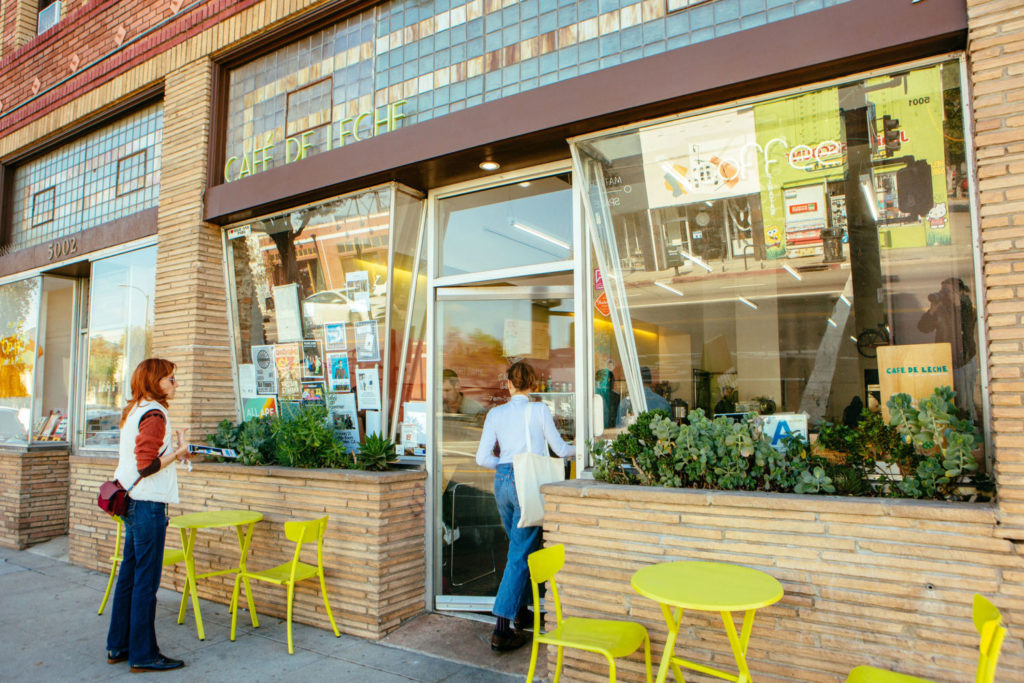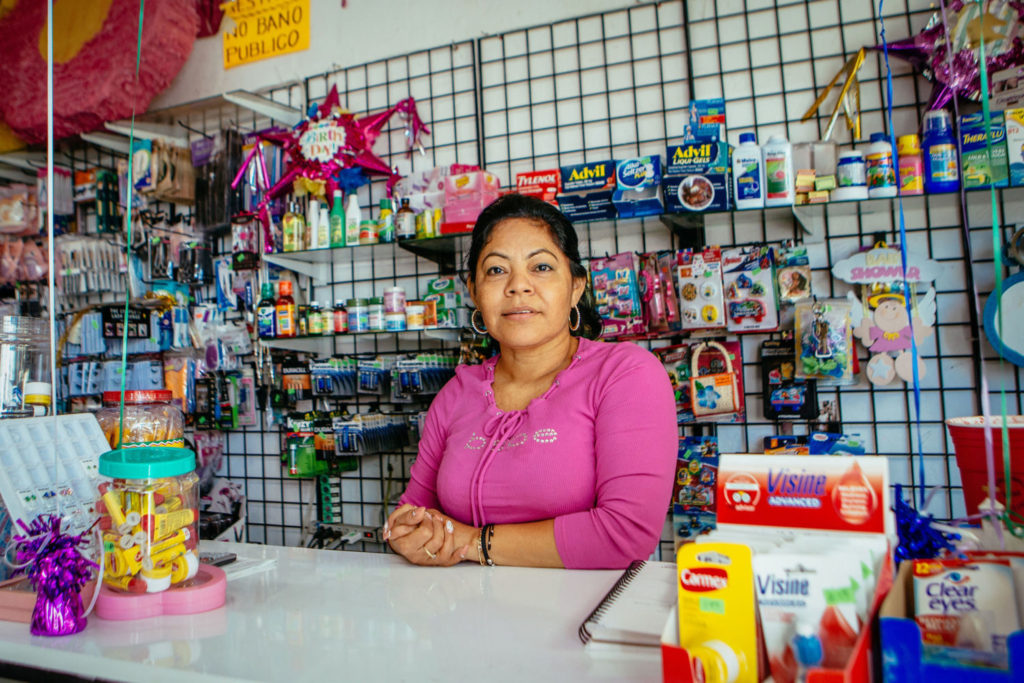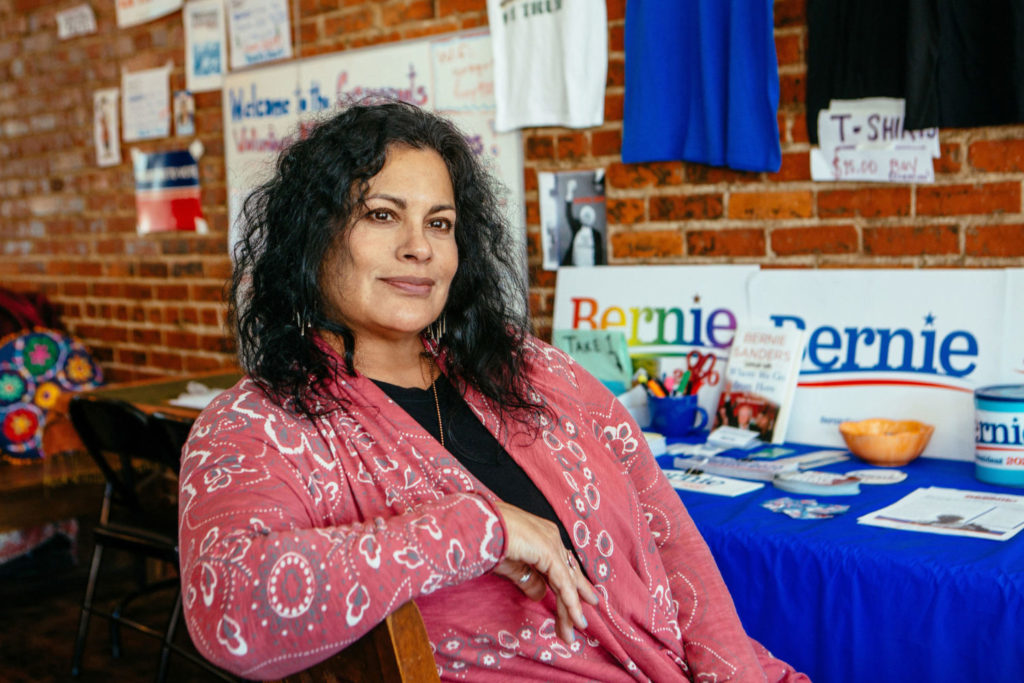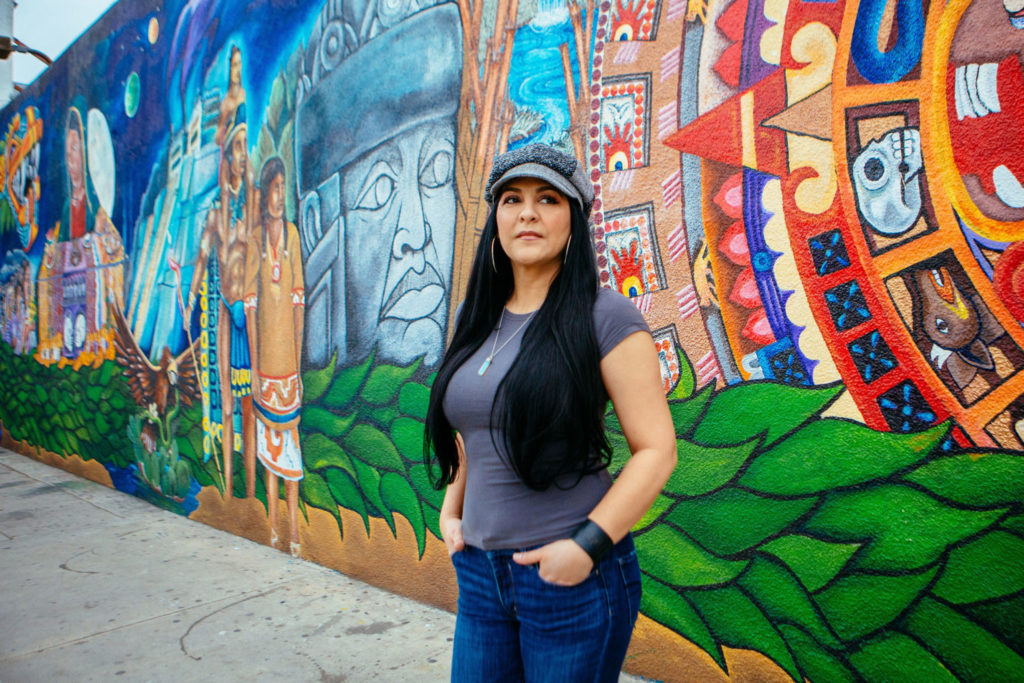L.A.’s hottest neighborhood is where the city’s existential crises have come home to roost.
Much like the restless cityscape that surrounds it, the two-story building with the decorative brickwork at the corner of Avenue 50 and York Boulevard in Highland Park hasn’t stopped changing for the better part of a century. Back in the days of trolley cars, when the Los Angeles Railway’s W line made a final stop directly outside, it served variously as an FBI outpost, a city council office and an old-fashioned horseshoe diner. When Quentin Tarantino used the building as a backdrop for a scene in “Reservoir Dogs” in the early 1990s (you may recall Steve Buscemi’s Mr. Pink running smack into the windshield of a moving car), it was a dowdy-looking insurance and real estate business across the street from a gas station.
Since 2008, a watershed year for Highland Park, the building has been the home of Café de Leche, an elegantly designed coffee shop “proudly serving oat milk,” with a roaster in the back and a large Nicaraguan flag in the bathroom. Just about everyone agrees the cafe’s arrival has been pivotal — either because its opening was the moment when a down-at-heel neighborhood found its focal point and groove in the form of a sorely needed meeting place for community-minded neighbors, artists and activists, or, as others insist, because it was the moment everything started going to hell.
Certainly, the coffee shop was a signal. First, to property investors who seized on a flurry of recessionary foreclosures to buy low and sell high, then to landlords looking to turn tidy profits of their own. Highland Park was the next Los Angeles neighborhood to up-and-come. Activists were appalled by what they saw as naked financial calculation at a time when dozens of local families were losing their livelihoods and their homes, and took to plastering “eviction notices” on the doors of Café de Leche and other new businesses “for not complying with the needs of the working class.”
These days, the coffee shop is rarely without a line at its counter or a crush of young professionals working away on their laptops in the light and airy seating area. The cafe’s owners have built up considerable goodwill in the community by, for example, donating coffee to LAUSD teachers during last year’s strike. Still, Café de Leche is not for everyone, not when a cup of horchata con espresso will set you back close to $5 and 12-ounce bags of locally roasted coffee (notes of milk chocolate and orange zest) retail at $20 a pop. “I don’t have anything against the place,” is a refrain much heard around Highland Park, especially among older residents, “I just can’t afford to go there.”
When people worry about gentrification and the squeezing of L.A.’s middle class, Highland Park is the sort of place they worry about. Not so long ago it was an unassuming, mildly depressed, Latino-majority suburb with a string of mom-and-pop style businesses along its two major thoroughfares — York Boulevard and Figueroa Street. Now, it is the hottest of hot properties, a magnet for young professionals who work downtown or in Hollywood, a place of spiraling rents, designer Craftsman cottage renovations, bars, restaurants and playfully curated boutiques catering not to anyone’s basic needs but to shopping as recreation — a House of Intuition filled with crystals and candles, a retro vinyl record store, a donut shop whose overpriced and over-wordsmithed menu choices include Fudgegazi, Yo La Mango and Husker Blu.

Driving all these changes is a red-hot demand for a limited stock of both residential and commercial real estate. The median cost of a single-family home in Highland Park has jumped from around $350,000 in 2010 to almost $800,000 now. Commercial rents have gone crazier still. The owner of the old Sunbeam Theater building on the corner of Figueroa Street and Avenue 58 — once a glorious palace of entertainment with an ornate circular marquee, now a rectangular block of drab storefronts — more than tripled rents overnight in 2018, forcing one of Highland Park’s quirkiest businesses, an old-school typewriter repair shop, to retreat to its owner’s private residence.
This trajectory is familiar to anyone who saw Silver Lake and Echo Park explode in the mid-2000s. The phenomenon shows every sign of spreading from Highland Park to neighboring communities like Montecito Heights, El Sereno and Lincoln Heights — anywhere, in fact, within easy commuter distance of L.A.’s booming center. Landlords are piling pressure on tenants to vacate rent-controlled properties, unfashionable businesses are forced to relocate or close and families who have resided affordably in these neighborhoods for decades face agonizing choices about where to live and work without losing half their income to rent or condemning themselves to long daily commutes.
When families fail to reconcile these often-conflicting priorities, homelessness becomes an abiding risk. Several students at Highland Park’s two high schools report that they are living out of their cars or staying with friends because their parents have moved across town, to the Valley or the Inland Empire, and they are trying to scrape by until they graduate.
All this upheaval points to bigger tectonic shifts across Los Angeles. Soaring real estate prices, fueled in part by the rise of the tech industry and the emergence of residential properties as a target for international investment funds, have put once semi-affordable coastal communities like Venice and Manhattan Beach out of reach to all but long-term residents and the gilded few. A similar, if less dramatic gentrifying wave has spilled out from downtown and Hollywood, prompting many first-time house buyers to look to the ring of suburbs beyond the neighborhoods that gentrified a decade ago: Highland Park and Boyle Heights, but also West Adams, Mid-City, Crenshaw, Leimert Park and Inglewood.
In one sense, this is good news because it means Los Angeles as a whole is on an upswing. Many of these newly desirable areas were not long ago bywords for white flight and urban neglect. But as long-standing residents of these neighborhoods get priced out, where are they supposed to go? The farther out they move, the higher their risk of losing access to decent schools, hospitals and other essential services. They would most likely also have to deal with environmental challenges like air and noise pollution, as well as having to spend ever more of their lives in cars.
And what happens to the fabric of the city they leave behind? Los Angeles is a more imperfect metropolis than most, driven for much of its history by deep racial and class divides. But it has also been a haven for waves of domestic transplants and immigrants and refugees from overseas conflicts; a place where Koreans, Iranians, Central Americans, Ethiopians and many others could find a toehold, build community and thrive.
In more recent times, Los Angeles has at least aspired to become a place where people of different backgrounds and income levels can coexist in the same urban space. That aspiration now competes with a more dystopian vision of the future, one in which the central sections of the city — the windsock that wraps around downtown and blows out due west to the coast — become an exclusive bastion of upper-middle-class privilege. Meanwhile those circling the orbit of this gilded elite, nannies, gardeners, restaurant and grocery workers, dry cleaners — even educators, social workers and police officers, have to endure ever diminishing economic returns and longer commutes from far-flung exurbs to service their needs.
The fear, in other words, is that we are becoming another San Francisco.
A Losing Battle?
Those caught up in this whirlwind tend to explain it one of two ways, neither of which offers a complete picture or a full explanation. The first casts the change as an out-and-out disaster movie, “Attack of the Fifty-Foot Hipsters,” in which the gentrifiers descend with their man buns, plaid shirts and BOB jogging strollers and, whether they realize it or not, lay waste to everything they touch. Every imagined improvement — the period houses they restore so lovingly (or that house-flippers restore for them), the chain-link fences they replace with horizontal wooden slats, the cafes and exercise studios that follow in their wake — conceals a tale of displacement and erasure.
“This plague, this cancer,” Brenda Perez, an anti-gentrification activist in Highland Park calls it. For years, she has been in the thick of a losing battle to keep residents in their rent-controlled homes, fighting landlords and the city to abide by their legal and contractual obligations. She watched helplessly as speculators, in the wake of the 2008 crash, descended on dozens of foreclosed homes and flipped them at vast profit. And she watched, appalled, as the new Highland Park overlords whitewashed neighborhood murals and replaced them with new, shinier-but-blander versions that to her smack of “McDonaldization.”
The idea that this could be blithely regarded as improvement — that as Highland Park native Billie Eilish told a music magazine a couple of years ago, “nobody really lived there,” until the hipsters arrived — enrages Perez beyond measure. “How different is this from the western frontier?” she says. “The mentality is, kill all things indigenous and hide them.”
Perez isn’t alone, many in Highland Park are reluctant to claim the Grammy-winning Eilish as one of their own after her statement.
The second story people tell is a classic booster narrative, that Highland Park is now a more vibrant, more diverse, safer and healthier place. It is not just newcomers who make this argument. Silvia Flores, who walked across the Mexican border as an undocumented immigrant 30 years ago and has, since 2006, managed the decidedly non-hipster Junior’s Discount Party Supply store across the street from Café de Leche, has no nostalgia for the days when the local economy struggled and members of the Avenidas gang made regular incursions up from Glassell Park and Cypress Park.
“There were too many cholos, bad people,” she says. “People were afraid to go out. Now they’re out walking the streets. It’s much better.” Likewise, Flores has little patience for the argument that gentrification has been a colonization of Latinos by privileged gringos. “They’re not just white people,” she says. “They’re from Argentina, Cuba, Brazil, all sorts of different places.”

Like Flores, plenty of natives and long-term residents have taken advantage of the improving local economy to expand their businesses or open new ones. The owner of the Café de Leche building, Yolanda Nogueira, has lived in the neighborhood her entire life and sees far more positive than negative in the changes. “I see it becoming healthier,” she says. “A lot of fancy places come and try to make a go of it, but they can’t sustain their business with the people who live here they’re going to fail.”
Nogueira is regarded as something of a neighborhood den mother and she struggles to understand the us-versus-them mentality that prompts anti-gentrification activists to rail against new liquor licenses (their drunk drivers hitting our innocent bystanders), or bicycle lanes (their bikes clogging up our traffic) or other obvious improvements like turning the gas station across the street from her building into a children’s park. Recently, Nogueira felt compelled to intervene when a particularly aggressive activist went after a vegetarian restaurant on Figueroa Street over its sidewalk seating. That level of anger, she said, was not warranted.
Each of these narratives is compelling in its way, but they miss the long view. The 2008 crash wasn’t the first significant upheaval for Los Angeles, nor, for that matter, were the early 1990s when the end of the Cold War knocked the legs out from under the local defense and aerospace industries. In one way or another, the urban landscape has been in crisis for close to a century thanks to near-constant housing shortages; a loose regulatory structure that has encouraged unfettered speculation and sprawl at the expense of community preservation and stability; and a shameful legacy of racial discrimination that has created long-term divisions between haves and have-nots, with continuing generational implications.

Crudely put, because homeownership was engineered along racial lines in the early 20th century — through covenants and other insidious instruments of public policy — the city was split between those in a position to realize long-term value from their property and those who were not. Yes, wealth compounded as L.A.’s fortunes rose, but so did poverty. And that created an ugly, ever-widening split in opportunity as well as income that even today’s more progressive political environment cannot easily correct.
While parts of Los Angeles have enjoyed reliable access to education and business investment funding and have generated enough family wealth to make down payments on the next wave of homeownership, other parts simply have not. And the less people have, the less likely it is that their children will gain that access either.
“What we’re dealing with,” says Ben Winter, a housing expert formerly with the mayor’s office, now with the California Community Foundation, “is the legacy of what kept black and brown people from entering the middle class.”
After the advent of the freeways, waves of white flight along the suburban corridors from downtown presented some opportunities to this semi-permanent underclass. It enabled many Latino families to make what they regarded as a step up from East Los Angeles to Highland Park, for example. Now that the center of gravity in Los Angeles is shifting back to the central core, some Latino homeowners are seizing the opportunity to cash in on the value of their homes and build up assets for retirement in a cheaper neighborhood. For renters, though, it is a different story. Many feel they are being pushed back down the socio-economic ladder when they never had a fair shot at clawing their way up.
The problem, in other words, is too big and too complex to place the blame on hipsters alone or to expect small business owners or local government leaders to address on their own. Widening income inequality and a shrinking middle class have been abiding features of American society since the Reagan era, and are particularly conspicuous in Los Angeles.
According to a 2017 study by USC’s Program for Environmental and Regional Equity, L.A. County ranks seventh in income inequality out of the country’s 150 largest metro areas, ranking even lower than the Bay Area. Job growth has lagged significantly behind the national average. And while top earners have seen robust wage growth over the past four decades, wages for the lowest earners — a segment that has grown from 30% of the population in 1979 to 37% now — have fallen by 25%. Not surprisingly, the study found that racial disparities are a significant drag on the local economy and that closing the gaps in income and employment between racial groups would have boosted our region by a staggering $380 billion in 2014.
Solutions to these problems have not exactly been beyond our reach. A model that has worked well for European and many East Coast cities has been to build a robust public transportation network and concentrate high-density housing around it. But until recently, Los Angeles rejected this vision roundly and consistently. This was a city that believed in deregulation, reinvention and limitless growth on its own terms. Either homeowners preferred a more suburban lifestyle — even if it meant removing themselves from the city center to afford it — or they chose to see development itself as the enemy. “We don’t want to live in Manhattan,” was the slogan in the 1980s, when Proposition U introduced a slew of downzoning ordinances and building restrictions. Ever since then, proposals to increase density in affluent neighborhoods have tended to turn into a not-in-my-backyard slugfest. Or they inspire backlash initiatives like Measure S, the anti-growth proposition that caught fire but ultimately failed at the ballot box in 2017.

The no-to-Manhattan argument is nonsensical because choking off the supply of housing can only exacerbate the trend toward a Manhattan-like concentration of wealth and speculative financing. And nobody is proposing skyscraper living. Rather, what political leaders and advocates like Ben Winter and state senator Scott Wiener want is to fill in the sprawl along L.A.’s bus and light rail routes, replacing straggly mini-malls that few frequent and nobody is likely to miss with seven or eight-story apartment buildings. Don’t think New York, think Berlin or Barcelona.
Winter argues that we have room to create vibrant neighborhoods out of the sprawl that previous generations have left behind and to keep the urban richness that rapidly gentrifying neighborhoods tend to lose. We have space that a Manhattan or a San Francisco could only dream of and if only we could build enough housing we can make the city more affordable for everyone.
The big obstacle is time and with it the belief that such a transformation is even possible. In 2016, L.A. voters signaled a remarkable willingness to break with the suburban mentality of the past when they approved ambitious ballot measures to expand public transportation, address homelessness and spur construction of affordable housing. But they have grown impatient in the years since because results have been maddeningly slow to materialize. Winter says this is because of the sheer scale of the challenge, which is not just about meeting the demands of future growth but catching up on accumulated need — a need that goes all the way back to the exclusionary policies and willful segregation of a century ago. “We have a big backlog,” he says, “that we can’t eat our way out of.”
A Structural and Financial Squeeze
The cultural life and health of a big city depends, in large part, on slack in the urban economy — the disposable household income and public and private funds available to pay for our artists and writers and musicians, and for many of the other intangibles that give us a sense not just of real estate and asphalt but of belonging. San Francisco is a particularly egregious example of a city that has priced itself out of many of the things that made it attractive in the first place, but it is far from the only one. Here, too, the great churn of urban change and displacement has touched more than the poor; it has robbed us of some vital part of the city’s soul and taken away things that even the richest and the most comfortable among us value and miss once they are gone.
Even as Los Angeles has recovered from the 2008 crash, it has built frustratingly little slack. Some of that has been due to a seismic shift in business models and delivery systems. Musicians can’t make money off Spotify. Filmmakers have lost the middle market that was once the glory of the Hollywood studio system, with knock-on effects for young actors even as the television market has expanded. And local journalism has shriveled, unable to come up with any durable answer to the challenges of the Internet.
Much of the squeeze, though, has been structural and financial. In too many neighborhoods, the cost of living has simply risen too fast, and households recovering from the recession have been unable to keep up.
Homeownership rates still have not bounced back to pre-2008 levels, even for white Angelenos. Blacks and Latinos who were disproportionately targeted by predatory lenders lag further behind. Only 25% of those who need federal housing assistance receive it, making renters far more vulnerable to eviction and homelessness, and at the same time, federal block grants to finance new residential housing have been slashed and, under the Trump administration, threatened with elimination. One reason why the $1.2 billion fund to subsidize supportive housing created by Proposition HHH has not made a perceptible difference to the homelessness crisis is because so much other capital funding has been lost since the recession. It’s hard to create forward motion when the ground is still crumbling beneath your feet.
Such are the broader economic factors informing the gentrification debate. What they tell us is that the crisis in our neighborhoods goes far beyond murals and $20-bags of coffee and the menus that used to be in two languages but are now predominantly in English. More significant than the power of one social class to muscle out another, perhaps, is the overall powerlessness of our institutions to manage or even to contain the damage to our urban fabric.
Powerlessness, though, does not necessarily mean failure. There is a certain dynamism to unfettered restlessness and change, which L.A. has fed off for much of its history. But it does breed mistrust, which is why neighborhoods like Highland Park are rife with it, and fingers get pointed in all sorts of directions — at hipsters, at city council officers, at house-flippers and real estate agents and members of local business improvement districts. It’s important to remember, though, that the loss of community cohesion did not start with any of these people. Nor are they equipped, on their own, to find any semblance of a solution.
L.A. was once a city full of thriving middle-class neighborhoods. In a month-long series Los Angeleno explores what we lose when an Affordable L.A. is just a dream. Join the conversation on social media with the hashtag #AffordableLA.
L.A’s Endangered Middle Class: An Examination by Los Angeleno staff
Not Homeless Yet: L.A.’s Invisible Class by Sam Slovick
What We Talk About When We Talk About the Middle Class by Michelle Chihara
For Many Black People, L.A. is No Longer the Last Best Place to Live by Erin Aubry Kaplan

